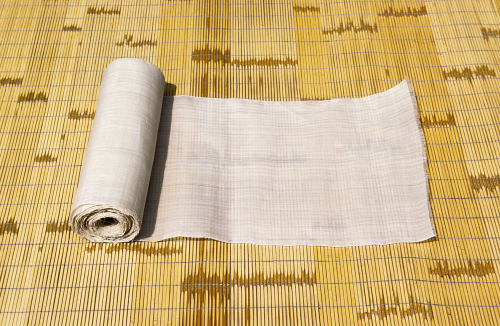Do you know Myeongju Jjagi (Silk Weaving)?
차민서 /
2023-11-11
HERITAGE
조회수 1115
-


-
Hello! My name is Minseo Cha and I am from Usco. Usco means youth storyteller culture organiztion. I will explain Myeongju Jjagi (Silk Weaving) which is registered for National Intangible Cultural Property in Korea. 안녕하세요 제 이름은 차민서이고 저는 유스코에서 왔습니다. 유스코는 youth storyteller culture organization 의 줄임말 입니다. 저는 한국의 국가무형문화재로 등록되어있는 명주짜기에 대한 내용을 설명하겠습니다. 사진출처: https://www.heritage.go.kr/unisearch/images/imp_intangible_cult_prop/2021071414535903.jpg https://www.heritage.go.kr/unisearch/images/imp_intangible_cult_prop/2021071414540003.jpg
-


-
Silk refers to a flat fabric made from insects called cocoons. It's cool and eco-friendly, right? Korea's silk wine has various advantages. Myeongju Jagi is one of Korea's traditional art techniques, with centuries of history and traditions. It has such a long history that records related to it have appeared since the time of Gojoseon. In the Goryeo Dynasty, higher quality silk fabrics were produced, and in the Joseon Dynasty, there were various types, so they were named for color and quality. Among them, silk is said to have been produced the most as fabric material. 명주라는 것은 누에고치라는 벌레를 이용하여 만든 평면 직물을 말합니다. 벌레로 만든다니, 신기하고 친환경적이죠? 한국의 명주짜기는 다양한 장점을 가지고 있습니다. 명주짜기는 한국의 전통적인 예술 기술 중 하나로, 수세기에 걸쳐 전해져온 역사와 전통을 지닙니다. 그와 관련된 기록이 고조선 때부터 나타날 정도로 오랜 역사를 가지고 있죠. 고려시대에는 보다 질이 좋은 견직물이 생산되었고, 조선시대에는 종류가 다양해서 색과 품질로 이름이 붙게 되었어요. 그 중 명주가 옷감재료로 가장 많이 생산되었다고 해요. 사진출처: https://www.heritage.go.kr/unisearch/images/imp_intangible_cult_prop/2021071414540000.jpg https://www.heritage.go.kr/unisearch/images/imp_intangible_cult_prop/2021071414535805.jpg
-


-
How does this unique silk weaving do? It might feel a little complicated. We start with growing mulberry trees and setting silkworms. The silk thread was made by putting cocoons in boiling water and then untying the ends of the thread and using tools such as grass to make the thread. Flying with silk thread, feeding grass with wemeggi, wrapping it in a dotumari, putting it on a loom, hanging the baby thread and tying the end of the thread around the horse's nose, the preparation for the silk weaving is complete. And then you're sitting on a loom, you're wearing a bootie around your waist, you're wearing a loom, you're pushing your feet back and forth, you're squeezing it. It's delicate and needs a lot of preparation. 이 독특한 명주짜기는 어떻게 하는 걸까요? 조금 복잡하게 느낄지도 모릅니다. 일단 뽕나무를 재배하고 누에를 치는 일부터 시작합니다. 명주실은 누에고치를 끓는 물에 넣은 뒤, 실 끝을 풀어서 자새 등의 기구로 실켜기를 해 타래실을 만든 것이죠. 명주실로 날실을 날고 베메기로 날실에 풀을 먹여 도투마리에 감아서 베틀에 올려 잉아실을 걸고 날실 끝을 말코에 매면 명주짜기 준비가 모두 끝나죠. 그 뒤에 베틀에 앉아 부티를 허리에 걸고 베틀신을 신고 발을 앞뒤로 밀고 당기며 짜게 되는 것이죠. 섬세하고 준비가 많이 필요합니다. 사진출처: https://www.heritage.go.kr/unisearch/images/imp_intangible_cult_prop/2021071414535803.jpg https://www.heritage.go.kr/unisearch/images/imp_intangible_cult_prop/2021071414540002.jpg
-


-
Myeongju Jagi can also be seen in various traditional Korean fairy tales. A woman who weaves this silk is usually called a jiknyeo, and because this silk weaving is delicate and beautiful, I think I've seen it a lot as the main character of traditional fairy tales related to love. In the past, households across the country used to weave silk with looms, but after the late Joseon Dynasty, machinery and industry developed, and clothes were produced in large quantities. The traditional silk valley was in sharp decline. Today, the demand for silk is decreasing due to the rise of colorful silk fabrics but, I hope that Korea's unique and useful silk wine will become more known and famous! 명주짜기는 한국의 다양한 전래동화에서도 볼 수 있습니다. 이 명주를 짜는 여성을 보통 직녀라고 하는데, 이러한 명주짜기는 섬세하고 우와하기 때문에 저는 사랑과 관련된 전래동화의 주인공으로도 많이 본 것 같아요. 과거에는 전국 각지의 가정에서 베틀로 명주를 짜 살았는데, 조선 후기이후 기계나 산업이 발전하며 대량으로 옷을 제작하게 되었어요. 재래식 명주짜기는 급격히 쇠퇴하게 되었죠. 오늘날에는 화려한 견직물에 밀려 명주의 수요가 줄어들고 있다 하지만, 이러한 한국만의 독특하고 활용적인 명주짜기가 더 많이 알려져 유명해지면 좋겠습니다! Drawing by Minseo 사진출처: 차민서가 직접 그렸습니다. https://www.heritage.go.kr/unisearch/images/imp_intangible_cult_prop/2021071414535801.jpg